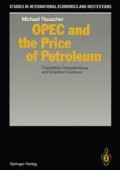Abstract
After World War II, petroleum has become the predominant energy source worldwide. From 1945 to 1973, its production increased eightfold and its share in energy consumption rose from 23 to 47%.12 This tremendous increase did not cause any problems as long as huge oil findings were made that increased the stock of known reserves even faster. It was in the early seventies when the finiteness of natural resources became an issue of public interest. The most popular publication was “Limits to Growth” by Meadows et al (1972). They reported (p. 58) that, given a growth rate of 3.9% per year, which at that time seemed to be a realistic forecast, proven petroleum reserves would be exhausted within twenty years. In the meantime, this estimate of the exhaustion period has turned out to be by far too pessimistic because of new additions to reserves and the demand slowdown. However, exhaustibility remains one of the major characteristics of the natural resource petroleum.
Access this chapter
Tax calculation will be finalised at checkout
Purchases are for personal use only
Preview
Unable to display preview. Download preview PDF.
References
SeeFesharaki/Isaak (1984), pp. 39, 44, and 50. For these different concepts of determining the availability of reserves seeColitti(1981) andRiva (1983), pp. 123–133. The following classification is based onColitti(1981), p. 9-10.
For a survey seeHart/Holmström (1987),On the advantages and disadvantages of contracting especially pp. 118–134. For long-term contracts in the resources industry, seeRoberts (1980),especially p. 246,andSiebert (1988a).
Hartshorn (1985), p. 62, States that since the second oil shock most of the contracts have not exceeded a year’s duration.
Roeber (1979), p. 49, Has expressed this fact the following way:If there is such a thing as ’the Rotterdam market’, it is not a market and it is not at Rotterdam.
Author information
Authors and Affiliations
Rights and permissions
Copyright information
© 1989 Springer-Verlag Berlin · Heidelberg
About this chapter
Cite this chapter
Rauscher, M. (1989). The world petroleum market: History and institutions. In: OPEC and the Price of Petroleum. Studies in International Economics and Institutions. Springer, Berlin, Heidelberg. https://doi.org/10.1007/978-3-642-83926-9_2
Download citation
DOI: https://doi.org/10.1007/978-3-642-83926-9_2
Publisher Name: Springer, Berlin, Heidelberg
Print ISBN: 978-3-642-83928-3
Online ISBN: 978-3-642-83926-9
eBook Packages: Springer Book Archive

